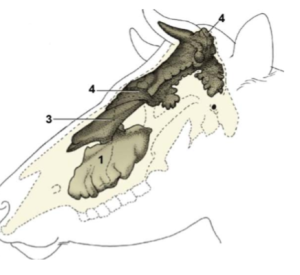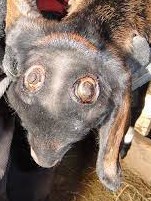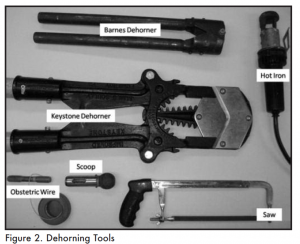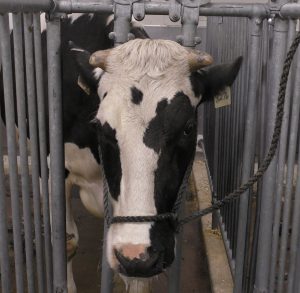FA youngstock processing
Disbudding and dehorning
Overview
Horns are removed to minimize trauma to other animals or handlers. Occasionally animals traumatize themselves and cause their own issues.
Dehorning is much more complex so most animals are disbudded early in life. When the horn bud starts to grow, it is purely a subcutaneous growth. At this stage, it can be removed or cells killed. Removal can be done by scoops (sharp gouges) or Barnes dehorners (nippers). Cells can be killed by chemical paste or cautery.
As the horn grows, it not only gets larger externally but also “dissolves” the skull bone, creating a direct and large communication with the frontal sinus. Now horn removal is not only harder (bigger tools and/or surgery) but also includes a sinusotomy. An open sinus can lead to sinus infection; sinusitis can lead to multiple other issues.

Analgesia
Meloxicam and other NSAIDs administered pre- and post-procedure provide detectable analgesia and improve weight gain. Meloxicam can be given in the milk a couple of hours prior to the procedure for easy administration.
Local anesthesia is recommended for all dehorning and disbudding surgical procedures. The cornual block is described under the dehorning chapter. Ontario Veterinary College has developed an easier method of local anesthesia – they inject lidocaine subcutaneously under the horn bud instead of trying to find the nerves. The same effect could be obtained with a ring block around the horn.
Some combine xylazine and lidocaine to provide sedation as well as local analgesia. See the video below.
Removal Methods
Chemical paste
Dehorning paste is applied to very small horn buds (calves 1 day- 3 weeks of age). It is caustic and causes local inflammation. Treated animals should not be allowed to nurse until the paste has dried as the paste can get on the dam’s udder, causing her to have localized inflammation. Rain can wash the paste into the eye causing injury. Sometimes it doesn’t work. If the cells are incompletely killed, some horn growth can still occur. The horn often grows abnormally in these cases. Such horns are called scurs. Depending on the formation of the horn and attitude of the goat, these scurs may need to be removed meaning dehorning was not avoided.
Hot iron dehorners

Special heat elements are used to cauterize the cells and prevent horn growth. This method can be effective in animals up to four months of age or one inch long horns. However, it is most readily done as soon as the horn bud is palpable. The hot iron is held on the bud with firm pressure until the skin turns copper colored. Not enough burn can result in scur formation. Too much can cause meningitis.
Tube or Scoop dehorners
These instruments have a sharp edge that can be used to gouge out a small horn bud. Different size scoops can handle horns up to 1.5″. This method is not bloodless so fly control is important. Too little of a gouge can result in a scur. Too much can damage the calvarium.

Barnes dehorners
Barnes dehorners act like a hedge trimmer or hoof nipper to cut through the tissues on both sides of the horn. This cutting action is combined with a twist to cause vascular spasm. Barnes comes in different sizes and can be used on older calves and larger horns. Separate cauterization is often needed to manage bleeding. Barnes should not be used on goats due to their softer skull.
Surgery
Older animals generally get surgery. The skin around the horn is cut to the bone and then tools used to cut through the horn. Gigli wire or surgical saws are used for horn removal. This will open the sinus and cause bleeding. Vessels are cauterized, hemostated or traumatized (Cornell cautery = pull the vessel out so it tears and spasms shut). The head should be bandaged to prevent infection or the site carefully monitored.
Horn tipping
Due to the trauma related to horn removal in cattle, horn tipping has become more prevalent. This method is used when the animal is dangerous because of the horn tips. A saw or gigli wire is used to remove the sharp tip of the horn. The top 4-5 cm of the horn is solid, denervated, and does not communicate with the frontal sinus. Pain and infection risk are negligible when the procedure is done correctly.

Polled bulls
You can also work toward breeding horns out of the population! Polledness is a dominant trait so a polled bull can be heterozygous for the trait. Genetic testing is available for certain breeds. See the UCDavis site.
Key Takeaways
Disbudding or polled breeds are much preferred over dehorning. Disbudding must be done in young animals. Dehorning at a later age opens up the sinus and increases risk of infection (including meningitis).
Analgesics (NSAIDs and local blocks) are strongly recommended.
Hot iron dehorning is a common method; go for the copper ring to ensure all horn cells are destroyed.
Resources
Calf dehorning, Ontario
Technique comparison page, MSU page 6
The Moos room podcast on dehorning
Horn tipping of livestock, Australia
AVMA position statement about dehorning
Other notes
Sandra Baxendell (6/30/19) – uses “Buccalgesic” – a form of meloxicam designed to absorbed through the oral mucous membranes. Let it work for 5 min (while clipping and weighing). Then she gives 4.5 mg/kg alphaxalone slowly iv (usually 2-3 mls). That gives just enough time to disbud if the iron is already hot.
Key Takeaways
- Disbudding should be done at a young age, using perioperative meloxicam, local blocks and/or sedation.
- Hot iron disbudding is most popular. Burn until a copper ring is achieved. Burn again if necessary. Don’t burn through the skull (brain is underneath)
- Scurs form if the bud is incompletely cauterized.
- Dehorning opens up the sinus and can lead to serious infections.
- Horn tipping is an option in adult cattle that are dangerous due to their horns.
Additional resources-
Miesner and Anderson. Surgical Management of Common Disorders of Feedlot Calves. Vet Clin Food Anim 31 (2015) 407–424
P Aubry. Routine Surgical Procedures in Dairy Cattle Under Field Conditions: Abomasal Surgery, Dehorning, and Tail Docking. Vet Clin Food Anim 21 (2005) 55–72
MN Hempstead et al. Pain sensitivity and injury associated with three methods of disbudding goat kids: Cautery, cryosurgical and caustic paste. The Veterinary Journal 239 (2018) 42–47
CD Neely et al. Effects of three dehorning techniques on behavior and wound healing in feedlot cattle. J. Anim. Sci. 2014.92:2225–2229
Disbudding on CCHP rotation
Xylazine sedation
Barrell/Knauer dehorning block and bovine sx dehorning block
Dehorning block using lidocaine + xylazine

